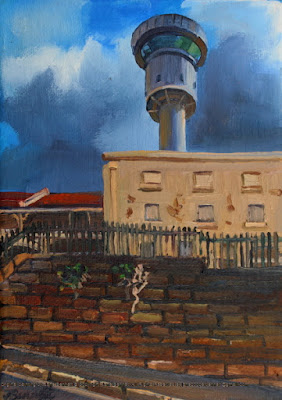.jpg) |
| P800 Sydney Harbour from Pyrmont 2023 oil on canvas 122 x 183cm |

.jpg) |
| P800 Sydney Harbour from Pyrmont 2023 oil on canvas 122 x 183cm |

The National Trust rejected a proposal by the Barangaroo Delivery Authority to demolish the tower while the City of Sydney council wanted it retained as an artwork or public lookout.
Some people suggested alternate uses for the empty tower: bungee jumping, abseiling, a viewing tower over Sydney Harbour, or a “pop-out” café.
However the Barangaroo Reserve project director Peter Funder said “We looked at a number of re-use options and it just wasn’t viable. It completes the vision we’re trying to deliver here of recreating the headland of Barangaroo.”
As for arguments about usefulness, you could also question what practical use does the Barangaroo Headland Park serve. It has allegedly been returned to the 1836 footprint, yet it is far from natural bushland, and the public certainly isn't permitted to hunt or fish there. So it is a construct - just as artificial as the concrete wharf it replaced.
This canvas painted in 2015 from the Stamford on Kent shows rows of lollipop like palm trees perched tier upon tier, as though on a giant wedding cake. The stairway to the top cuts through the cake like a knife cutting a slice out of the cake. Symmetrical and hierarchical, and as unlike real bushland as the horses on a carousel are from the living animals.

MP45 Barangaroo Headland Park from the
Stamford on Kent 2015 oil on canvas 122 x 153cm
COLLECTION: MITCHELL LIBRARY, STATE LIBRARY OF NSW
Enquiries
Its main function seems to be as a distraction from the scale of the southern end.
A spoonful of sugar to make the development go down.
A sort of 'Trojan park' under which is smuggled the true purpose of Barangaroo; to separate punters from their money.
It's a pity that almost all evidence of Sydney as an industrial port has been wiped away. I certainly found poetry in it.
I can't get used to the lack of Tower in the streetscapes of Millers Point - they look strangely empty now.
Related Posts
 |
| BAR60 'Barangaroo north - The Harbour Tower, escarpment and Moore's Wharf 2' 2010 oil on canvas 38 x 76cm |
 |
| BAR60 'Barangaroo north - The Harbour Tower, escarpment and Moore's Wharf 2' 2010 oil on canvas 38 x 76cm |



 |
MW16 'North Barangaroo Headland Park- The 'Blue Line' from Moore's Wharf ' 2011 oil on canvas 31 x 61cm |
 |
| MW28 'North Barangaroo Headland Park - The caissons from Moore's Wharf ' 2013 oil on canvas 36 x 46cm Enquiries about this painting |